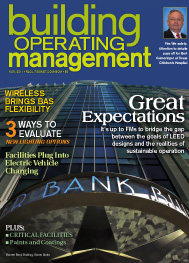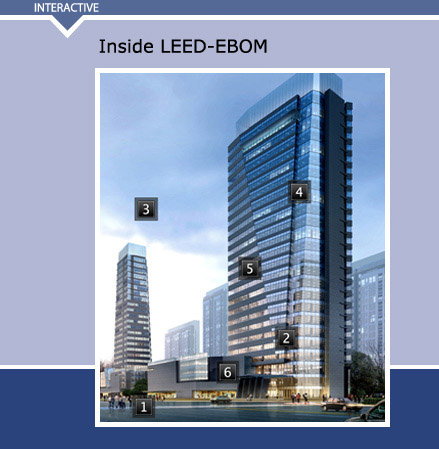
Great Expectations
It's up to FMs to bridge the gap between the goals of LEED design and the realities of sustainable operation.
By Greg Zimmerman,
Executive Editor

|
There are several ways facility managers can bridge the gap between the potential of a sustainable design and an efficiently operating building. In this integrated package, Bridging the Gap looks at strategies and tools facility managers should consider for ensuring their buildings achieve their full sustainable potential.
 

 One of the most frequently asked questions regarding the performance of LEED-certified buildings is, if a building doesn't hit a particular benchmark, will LEED certification be stripped? So far, the U.S. Green Building Council (USGBC) has not made any formal statement regarding the possibility of stripping LEED certification. What it has done, though, is created a Minimum Program Requirement for LEED that requires owners to submit five years of energy and water data on any LEED project. Combined with owners who voluntarily submit data, this initiative is known as the Building Performance Partnership (BPP) — and it's hoped that this data will provide a more complete picture of how LEED buildings perform over the long-term. Scot Horst, senior vice president of LEED, USGBC, talks about the program and how it will be used to recertify, not decertify, buildings. One of the most frequently asked questions regarding the performance of LEED-certified buildings is, if a building doesn't hit a particular benchmark, will LEED certification be stripped? So far, the U.S. Green Building Council (USGBC) has not made any formal statement regarding the possibility of stripping LEED certification. What it has done, though, is created a Minimum Program Requirement for LEED that requires owners to submit five years of energy and water data on any LEED project. Combined with owners who voluntarily submit data, this initiative is known as the Building Performance Partnership (BPP) — and it's hoped that this data will provide a more complete picture of how LEED buildings perform over the long-term. Scot Horst, senior vice president of LEED, USGBC, talks about the program and how it will be used to recertify, not decertify, buildings.


 As LEED-EBOM, a tailor-made blue print for how to realize the potential of a LEED-certified design, has evolved, the U.S. Green Building Council has attempted to make it easier to connect the New Construction (NC) and EBOM rating systems. Owners earn four points for starting EBOM with a LEED-certified building, a relatively high weighting for a single credit. Additionally, owners' LEED registration fees are waived (normally, it costs $900 for USGBC members and $1,200 for non-members) if an owner is registering a building for LEED-EBOM certification that was certified under LEED-NC prior to Jan. 1, 2011. And finally, for any LEED-EBOM project, recertification is required a minimum of every five years. This video podcast looks at The Christman Building in Lansing, Mich. Owners used LEED-EBOM to transform a poor performing building into a high-performing one, ultimately securing a LEED-EBOM Platinum certification. As LEED-EBOM, a tailor-made blue print for how to realize the potential of a LEED-certified design, has evolved, the U.S. Green Building Council has attempted to make it easier to connect the New Construction (NC) and EBOM rating systems. Owners earn four points for starting EBOM with a LEED-certified building, a relatively high weighting for a single credit. Additionally, owners' LEED registration fees are waived (normally, it costs $900 for USGBC members and $1,200 for non-members) if an owner is registering a building for LEED-EBOM certification that was certified under LEED-NC prior to Jan. 1, 2011. And finally, for any LEED-EBOM project, recertification is required a minimum of every five years. This video podcast looks at The Christman Building in Lansing, Mich. Owners used LEED-EBOM to transform a poor performing building into a high-performing one, ultimately securing a LEED-EBOM Platinum certification.


 A program called Designed to Earn the Energy Star certifies energy efficient design. One reason that energy efficient design doesn't translate into energy efficient operation is that designs usually aren't based on specific, easily measurable goals for energy efficiency. One way to solve that problem is to set a design goal of achieving a specific Energy Star rating for the building. That's the idea behind Designed to Earn the Energy Star, a program that certifies building designs. This video podcast takes a look at how Designed to Earn can help bridge the gap between design and operation and offers advice from one facility manager who has used the program on three projects. A program called Designed to Earn the Energy Star certifies energy efficient design. One reason that energy efficient design doesn't translate into energy efficient operation is that designs usually aren't based on specific, easily measurable goals for energy efficiency. One way to solve that problem is to set a design goal of achieving a specific Energy Star rating for the building. That's the idea behind Designed to Earn the Energy Star, a program that certifies building designs. This video podcast takes a look at how Designed to Earn can help bridge the gap between design and operation and offers advice from one facility manager who has used the program on three projects.


 Outcome-based codes — codes that stipulate a building's design performs to set operational standards — as well as many of the new energy reporting initiatives in states like California and Washington, force building owners to focus on operational energy use, and specifically operational practices and tenant behavior. In addition, outcome-based codes offer greater opportunity for innovation in meeting energy efficiency targets and the chance to preserve historically or architecturally significant features in existing buildings, which may be sacrificed in traditional compliance paths of energy codes. The pilot phase of the first outcome-based code is about to launch in Seattle and is also being considered as a path for the IGCC. Outcome-based codes — codes that stipulate a building's design performs to set operational standards — as well as many of the new energy reporting initiatives in states like California and Washington, force building owners to focus on operational energy use, and specifically operational practices and tenant behavior. In addition, outcome-based codes offer greater opportunity for innovation in meeting energy efficiency targets and the chance to preserve historically or architecturally significant features in existing buildings, which may be sacrificed in traditional compliance paths of energy codes. The pilot phase of the first outcome-based code is about to launch in Seattle and is also being considered as a path for the IGCC.

|






















